Lecture Materials
High-order and Gaussian quadratures#
Recall some of the standard techniques for numerical integration that we covered:
Rectangle rule
Trapezoidal rule
Simpson’s rule
All these rules can be written in a form
i.e. the integral is approximated as a sum integrand evaluations at various points with various weights. In particular, we have
Rectangle rule
Trapezoidal rule
Simpson’s rule
Different numerical schemes correspond to different choices of \(x_k\) and \(w_k\).
The only unique constraint is that the sum of weights should be equal to
such that the scheme gives correct result for the integration of a constant function.
High-order quadratures#
There is a systematic way to derive a numerical integration scheme
which will give an exact result when the integrand \(f(x)\) is a polynomial up to a certain degree.
Let us assume that \(f(x)\) can be calculated at \(N+1\) points inside the integration interval \((a,b)\). Recall that function \(f(x)\) evaluated at \(N+1\) distinct points can be approximated by an interpolating polynomial of order \(N\):
Here \(L_{N,k}(x)\) are the Lagrange basis functions
The approximation \(f(x) \approx p_N(x)\) becomes exact when \(f(x)\) is a polynomial of degree \(N\).
Integrating \(p_N(x)\) gives the following numerical quadrature:
where
Remapping
Note that one only really needs to calculate the quadratures (the nodes and weights) once for a single interval [typically (-1.,1.)]. The corresponding \((-1,1)\) quadrature can always be mapped to any finite interval \((a,b)\) by the following tranformation
Generic integration using quadratures#
# Generic integration using quadratures
def integrate_quadrature(
f, # Function to be integrated
quad # A pair of lists (x,w) where x are the integration nodes and w are the weights
):
ret = 0.
n = len(quad[0])
for k in range(n):
xk = quad[0][k]
wk = quad[1][k]
ret += wk * f(xk)
return ret
Newton-Cotes quadrature#
The simplest assumption is to take the \(x_k\) to be distributed equidistantly. This is called Newton-Cotes quadrature. The integral is approximated as
but two scenarios are possible: the points \(x_k\) either (a) include the endpoints \((a,b)\) or (b) exclude the endpoint.
In the case (a) we have a closed Newton-Cotes quadrature
while in case (b) we have an open Newton-Cotes quadrature
The weights \(w_k\) can be evaluated just once using e.g. one of the earlier developed methods of numerical integration, such as the Romberg method.
The Newton-Cotes quadratures give exact answer for the integration of polynomials up to degree \(N\).
# Calculating the weights using the Romberg method
# to requested accuracy for a given set of nodes x
# over the interval (a,b)
def compute_weights(x,
a,
b,
tol = 1.e-15):
ret = []
for k in range(0,len(x)):
tx = x
def f(t):
return Lnj(t, k, x) # Lnj is the Lagrange basis function from Lecture 2
ret.append(romberg(f, a, b, tol))
return ret
# Calculate the nodes and weights of either
# closed or open Newton-Cotes quadrature
# to requested accuracy
def newton_cotes(n,
a = -1.,
b = 1.,
isopen = False,
tol = 1.e-15):
x = []
if (isopen):
h = (b - a) / (n + 2.)
x = [a + (i+1)*h for i in range(0,n+1)]
else:
h = (b - a) / n
x = [a + i*h for i in range(0,n+1)]
return x, compute_weights(x, a, b, tol)
Open Newton-Cotes rule for N = 0 gives the rectangle rule
# Open Newton-Cotes rule with N = 0 gives the rectangle rule
newton_cotes(0, -1., 1., True)
([0.0], [np.float64(2.0)])
Closed Newton-Cotes rule for N = 1 gives the trapezoidal rule
# Closed Newton-Cotes rule with N = 1 gives the trapezoidal rule
newton_cotes(1, -1., 1., False)
([-1.0, 1.0], [np.float64(1.0), np.float64(1.0)])
Closed Newton-Cotes rule with N = 2 gives the Simpson’s rule
# Closed Newton-Cotes rule with N = 2 gives the Simpson's rule
newton_cotes(2, -1., 1., False)
([-1.0, 0.0, 1.0],
[np.float64(0.3333333333333333),
np.float64(1.3333333333333333),
np.float64(0.3333333333333333)])
Newton-Cotes quadrature permits negative weights
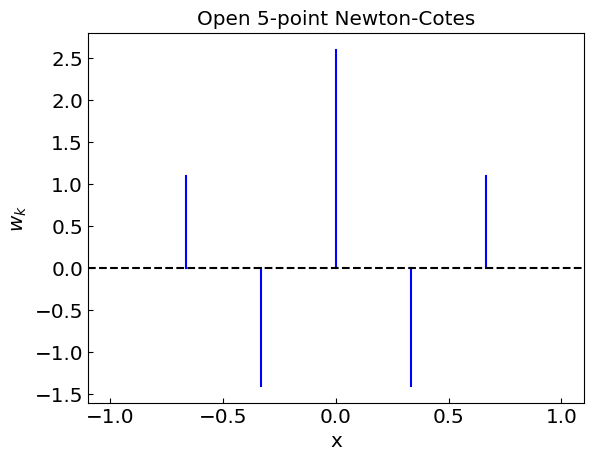
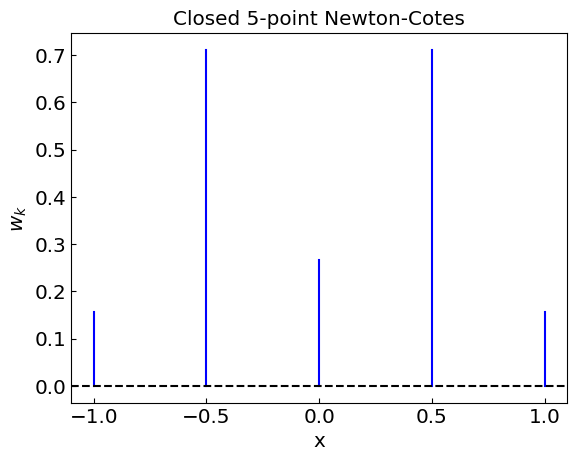
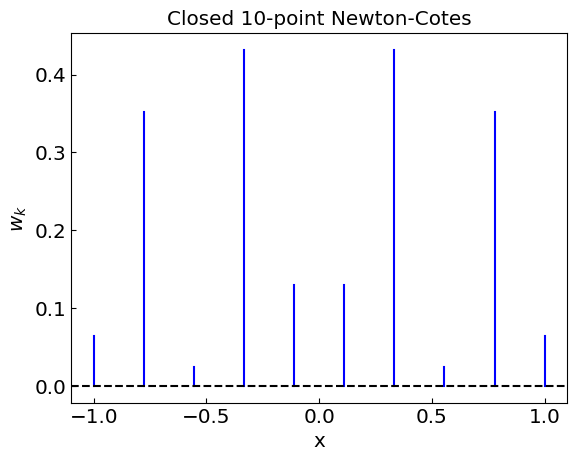
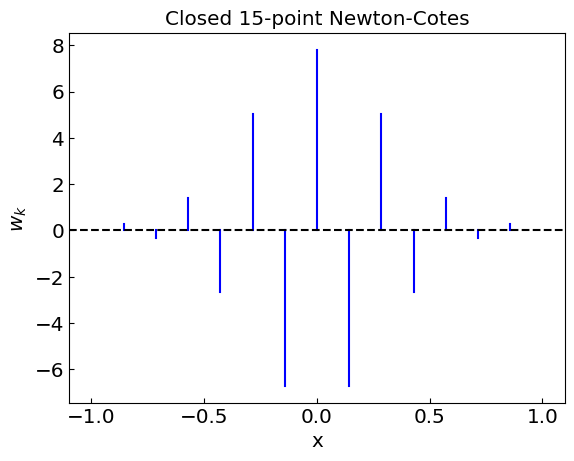
Let us now apply Newton-Cotes quadratures to the integration of a polynomial we had before
# Take our function example from last lecture
flabel = 'x^4 - 2x + 2'
def f(x):
return x**4 - 2*x + 2
flimit_a = 0.
flimit_b = 2.
# Open Newton-Cotes integration
print("Computing the integral of",flabel, "over the interval (",flimit_a,",",flimit_b,") using open Newton-Cotes quadratures")
print("{0:>10} {1:>20}".format("N", "I_N"))
for N in range(0,8):
quadr = newton_cotes(N, flimit_a, flimit_b, True)
integral = integrate_quadrature(f, quadr)
print("{0:>10} {1:>20.16f}".format(N, integral))
# Closed Newton-Cotes integration
print("Computing the integral of",flabel, "over the interval (",flimit_a,",",flimit_b,") using closed Newton-Cotes quadratures")
print("{0:>10} {1:>20}".format("N", "I_N"))
for N in range(1,8):
quadr = newton_cotes(N, flimit_a, flimit_b, False)
integral = integrate_quadrature(f, quadr)
print("{0:>10} {1:>20.16f}".format(N, integral))
Computing the integral of x^4 - 2x + 2 over the interval ( 0.0 , 2.0 ) using open Newton-Cotes quadratures
N I_N
0 2.0000000000000000
1 3.3580246913580254
2 6.1666666666666661
3 6.2378666666666671
4 6.4000000000000039
5 6.3999999999999986
6 6.4000000000000021
7 6.4000000000000039
Computing the integral of x^4 - 2x + 2 over the interval ( 0.0 , 2.0 ) using closed Newton-Cotes quadratures
N I_N
1 16.0000000000000000
2 6.6666666666666661
3 6.5185185185185182
4 6.4000000000000004
5 6.4000000000000012
6 6.3999999999999986
7 6.4000000000000004
Newton-Cotes quadratures work well when the integrand is a polynomial since in this case the interpolating polynomial approximates the integrand exactly
However, issues may arise when the interpolating polynomial does not approximate the integrand well, as was in the case of the Runge function
rungelabel = "Runge function"
def runge(x):
return 1./(25*x**2 + 1.)
runge_a = -1.
runge_b = 1.
# Open Newton-Cotes integration
print("Computing the integral of",rungelabel, "over the interval (",runge_a,",",runge_b,") using open Newton-Cotes quadratures")
print("{0:>10} {1:>20}".format("N", "I_N"))
for N in range(0,8):
quadr = newton_cotes(N, runge_a, runge_b, True)
integral = integrate_quadrature(runge, quadr)
print("{0:>10} {1:>20.16f}".format(N, integral))
# Closed Newton-Cotes integration
print("Computing the integral of",rungelabel, "over the interval (",runge_a,",",runge_b,") using closed Newton-Cotes quadratures")
print("{0:>10} {1:>20}".format("N", "I_N"))
for N in range(1,15):
quadr = newton_cotes(N, runge_a, runge_b, False)
integral = integrate_quadrature(runge, quadr)
print("{0:>10} {1:>20.16f}".format(N, integral))
Computing the integral of Runge function over the interval ( -1.0 , 1.0 ) using open Newton-Cotes quadratures
N I_N
0 2.0000000000000000
1 0.5294117647058825
2 -0.2988505747126436
3 0.2666666666666667
4 2.0404749055585549
5 0.9320668542657328
6 -2.0045340869981669
7 -0.1816307907657775
Computing the integral of Runge function over the interval ( -1.0 , 1.0 ) using closed Newton-Cotes quadratures
N I_N
1 0.0769230769230769
2 1.3589743589743588
3 0.4162895927601810
4 0.4748010610079575
5 0.4615384615384615
6 0.7740897346941600
7 0.5797988819496757
8 0.3000977814255821
9 0.4797235795683667
10 0.9346601111306989
11 0.6489545880557170
12 -0.0625873031506956
13 0.3839594433665099
14 1.5799089281703083
Integration of Runge’s function using Newton-Cotes quadratures does not give an accurate answer because high oscillations at the edges of the integration. Romberg method on the other hand gives an accurate estimate
# Romberg method
print("Computing the integral of",rungelabel, "over the interval (",runge_a,",",runge_b,") using Romberg method")
print(romberg(runge, runge_a, runge_b))
Computing the integral of Runge function over the interval ( -1.0 , 1.0 ) using Romberg method
0.549360306777909
Clenshaw-Curtis quadrature#
Newton-Cotes method can be improved by adjusting the choice of nodes. For instance, we learned that Chebyshev nodes minimize the Runge phenomenon in polynomial interpolation.
A quadrature based on Chebyshev nodes is called Clenshaw-Curtis quadrature. The weights of Clenshaw-Curtis quadrature can be efficiently computed using discrete cosine transform but for the present purposes we will using the straightforward numerical integration
def chebyshev_nodes(n,a,b):
return [(a+b)/2. + (b-a) / 2. * np.cos((2.*k+1.)/(2.*n+2.)*np.pi) for k in range(n+1)]
def clenshaw_curtis(n, a = -1., b = 1., tol = 1.e-15):
x = chebyshev_nodes(n,a,b)
return x, compute_weights(x, a, b, tol)
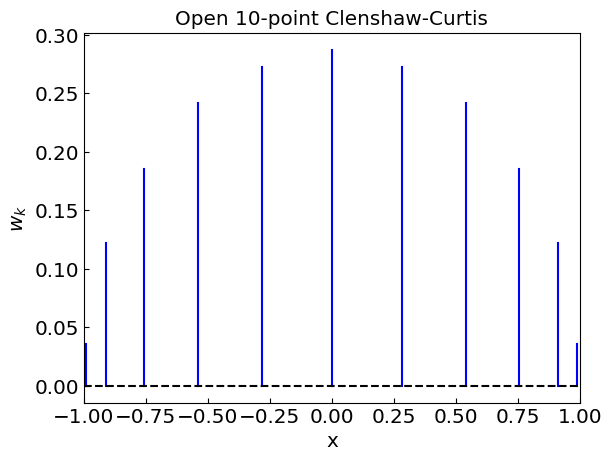
The nodes of Clenshaw-Curtis quadrature are all positive, which is not the case for the Newton-Cotes quadrature. This helps to avoid large cancellation errors in the integration.
Let us integrate the Runge function using Clenshaw-Curtis quadrature
# Clenshaw-Curtis integration
print("Computing the integral of",rungelabel, "over the interval (",runge_a,",",runge_b,") using closed Clenshaw-Curtis quadratures")
print("{0:>10} {1:>20}".format("N", "I_N"))
for N in range(0,25):
quadr = clenshaw_curtis(N, runge_a, runge_b)
integral = integrate_quadrature(runge, quadr)
print("{0:>10} {1:>20.16f}".format(N, integral))
Computing the integral of Runge function over the interval ( -1.0 , 1.0 ) using closed Clenshaw-Curtis quadratures
N I_N
0 2.0000000000000000
1 0.1481481481481482
2 1.1561181434599159
3 0.3393357342937174
4 0.7366108212029662
5 0.4422623071358261
6 0.6363602552248223
7 0.4995830749190563
8 0.5839263513091471
9 0.5259711610228504
10 0.5661564732597759
11 0.5388727075897808
12 0.5562316021895978
13 0.5445109449451717
14 0.5527811219474377
15 0.5472112438100144
16 0.5507349751776419
17 0.5483645031315993
18 0.5500702958302579
19 0.5489233775473976
20 0.5496321498366131
21 0.5491557069456035
22 0.5495101923607436
23 0.5492719294992722
24 0.5494126772553229
The Clenshaw-Curtis quadrature does show convergence, albeit a somewhat slow one
Gaussian quadrature#
Gauss-Legendre quadrature#
It turns out that the choice of nodes \(x_k\) can be improved further such that an \(n\)-point quadrature
gives an exact result for any polynomial of degree \(2n - 1\).
Let us take the integration range as \((-1,1)\) [it always be rescaled back to \((a,b)\)]. The derivation of the nodes \(x_k\) and weights \(w_k\) is a bit tedious. The outcome is that the nodes \(x_k\) correspond to the roots of the Legendre polynomial \(P_n(x)\).
The nodes \(x_k\) can in principle be found as roots of \(P_n(x)\) using the methods we developed earlier, while the weights \(w_k\) are evaluated through numerical integration of Lagrange basis functions. \(P_n(x)\) can itself be evaluated through a recurrence relation
starting from \(P_0(x) = 1\) and \(P_1(x) = x\).
This method is not the most efficient one and prone to large round-off error starting from (\(n \sim 20\)) (try it!).
More efficient methods exists. These calculate the roots of \(P_n(x)\) using analytic approximation for the initial guess and use the recursion formula directly to calculate the \(P_n(x)\) at given \(x\) rather than for pre-calculating the polynomial coefficients. The weights can also be shown to be equal to
An efficient implementation can be found in M. Newman “Computational Physics” textbook http://www-personal.umich.edu/~mejn/cp/programs/gaussxw.py
The nodes and weights resemble the ones of the Clenshaw-Curtis quadrature.
Let us test the integration of the Runge function using the Gauss-Legendre quadrature.
# Gauss-Legendre quadrature integration
print("Computing the integral of",flabel, "over the interval (",flimit_a,",",flimit_b,") using Gauss-Legendre quadratures")
print("{0:>10} {1:>20}".format("N", "I_N"))
for N in range(1,8):
quadr = gaussxwab(N, flimit_a, flimit_b)
integral = integrate_quadrature(f, quadr)
print("{0:>10} {1:>20.16f}".format(N, integral))
Computing the integral of x^4 - 2x + 2 over the interval ( 0.0 , 2.0 ) using Gauss-Legendre quadratures
N I_N
1 1.9999999999999969
2 6.2222222222222303
3 6.4000000000000066
4 6.4000000000000208
5 6.4000000000000190
6 6.4000000000000021
7 6.4000000000000083
From \(N = 3\) the result of integrating a quartic polynomial is exact to machine precision!
Let us try now a cubic polynomial.
# Another example, cubic function: trapezoidal rule vs 2-point gauss-legendre
def f2(x):
return 7. * x**3 - 8. * x**2 - 3. * x + 3.
a = -1.
b = 1.
trapezoidal = newton_cotes(1, -1., 1., False)
clenshawcurtis = clenshaw_curtis(1, -1., 1.)
gaussn2 = gaussxwab(2, -1., 1.)
print("Computing the integral of","7x^3-8x^2-3x+3", "over the interval (",-1.,",",1.,")")
print(" Trapezoidal:", integrate_quadrature(f2, trapezoidal))
print("Clenshaw-Curtis:", integrate_quadrature(f2, clenshawcurtis))
print(" Gauss-Legendre:", integrate_quadrature(f2, gaussn2))
Computing the integral of 7x^3-8x^2-3x+3 over the interval ( -1.0 , 1.0 )
Trapezoidal: -10.0
Clenshaw-Curtis: -2.0
Gauss-Legendre: 0.6666666666666641
The exact result is \(2/3\) and it is achieved already for \(N = 2\).
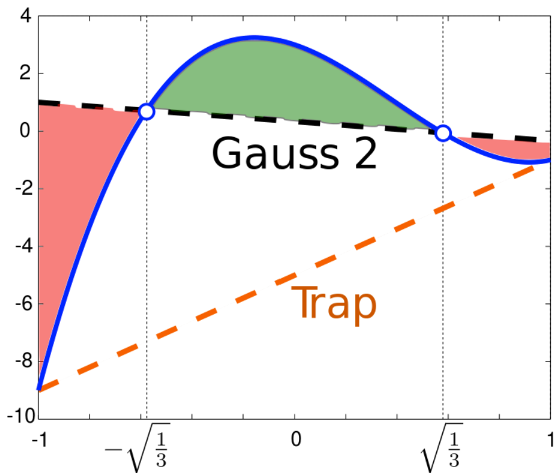
Generalized Gaussian quadratures#
The method of Gaussian quadratures can be generalized to integrals of the following type
Here \(a\) and \(b\) need not necessarily have to correspond to a finite interval, and the integration of \(f(x)\) is performed with a weight function \(\omega(x)\). In this case it is possible to construct an \(n\)-point quadrature which provides exact answer when \(f(x)\) is a polynomial of degree up to \(2n - 1\). The weights \(w_k\) are given by
Here \(x_k\) correspond to the roots of a polynomial \(p_n(x)\) satisfying the relation
For \(a = -1\), \(b = 1\), and \(\omega(x) = 1\), \(p_n(x)\) corresponds to \(n\)th Legendre polynomial as discussed before.
Other common possibilities are
Jacobi polynomials \(P_n^{(\alpha,\beta)}(x)\)
interval \((-1,1)\)
\(\omega(x) = (1-x)^\alpha \, (1+x)^{\beta}\)
Laguerre polynomials \(L_n(x)\)
interval \([0,\infty)\)
\(\omega(x) = e^{-x}\)
Hermite polynomials \(H_n(x)\)
interval \((-\infty, \infty)\)
\(\omega(x) = e^{-x^2}\)
For all these cases efficient methods exist for calculating the nodes \(x_k\) and the weights \(\omega_k\) accurately. This calculation has to be done only once.
Gauss-Laguerre quadrature#
Gauss-Laguerre quadrature is a method for numerical integration of functions of the form
For \(f(x)\) being a polynomial of degree up to \(2n - 1\), the quadrature gives exact answer.
The nodes \(x_k\) correspond to the roots of the \(n\)th Laguerre polynomial \(L_n(x)\). We can use sympy to compute the nodes and weights for \(n\)-point Gauss-Laguerre quadrature.
import sympy
# Nodes and weight for n-point Gauss-Laguerre quadrature
def laguerrexw(n):
x = sympy.Symbol("x")
roots = sympy.Poly(sympy.laguerre(n, x)).all_roots()
x_i = [float(rt.evalf(20)) for rt in roots]
w_i = [float((rt / ((n + 1) * sympy.laguerre(n + 1, rt)) ** 2).evalf(20)) for rt in roots]
return x_i, w_i
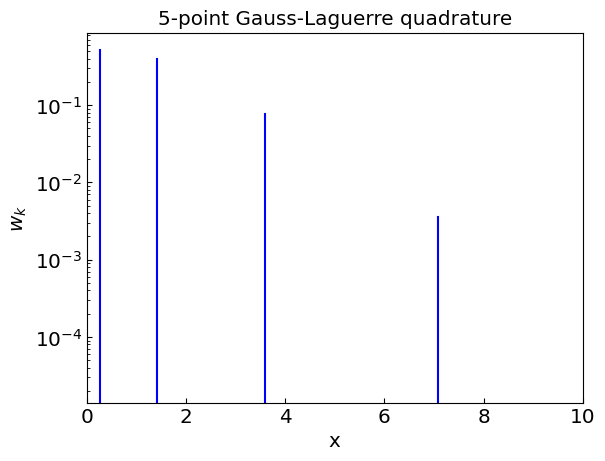
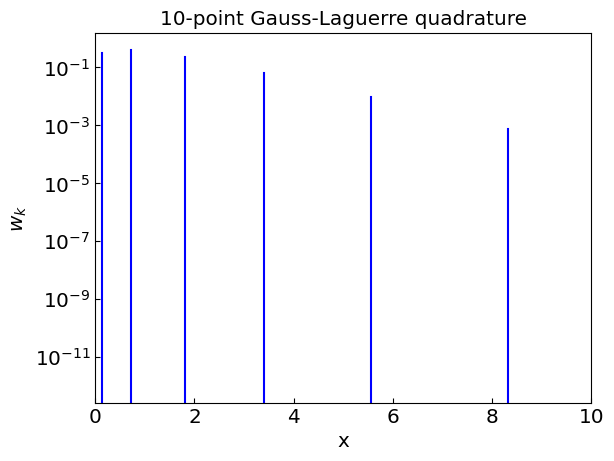
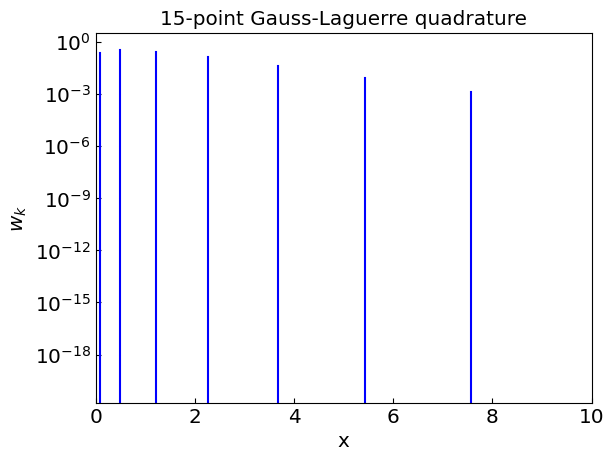
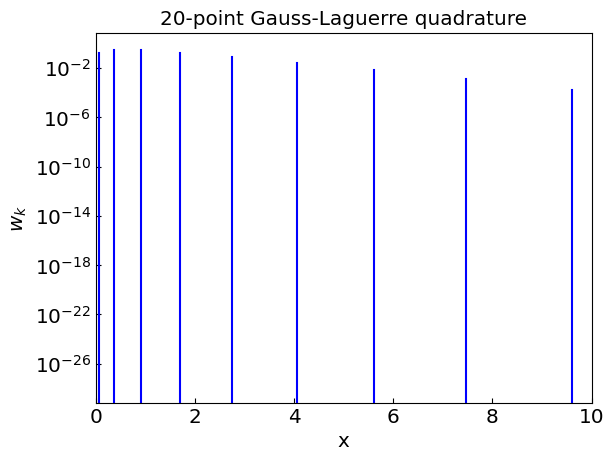
Gauss-Hermite quadrature#
Gauss-Hermite quadrature is a method for numerical integration of functions of the form
For \(f(x)\) being a polynomial of degree up to \(2n - 1\), the quadrature gives exact answer.
The nodes \(x_k\) correspond to the roots of the \(n\)th Hermite polynomial \(H_n(x)\).
import sympy as sympy
import math
# Nodes and weight for n-point Gauss-Hermite quadrature
def hermitexw(n):
x = sympy.Symbol("x")
roots = sympy.Poly(sympy.hermite(n, x)).all_roots()
x_i = [float(rt.evalf(20)) for rt in roots]
w_i = [float(2**(n-1) * math.factorial(n) * np.sqrt(np.pi) / ((n**2) * sympy.hermite(n - 1, rt)**2).evalf(20)) for rt in roots]
return x_i, w_i
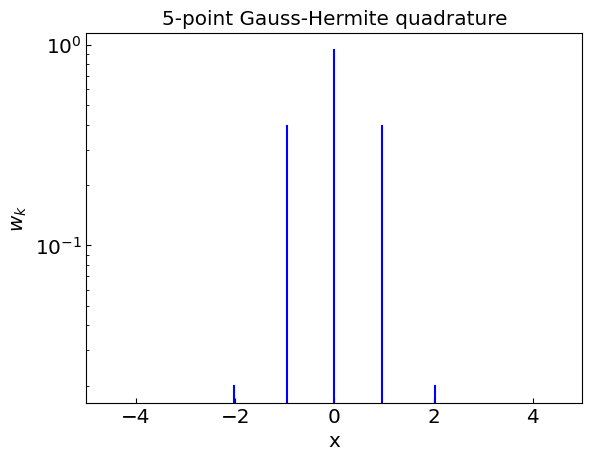
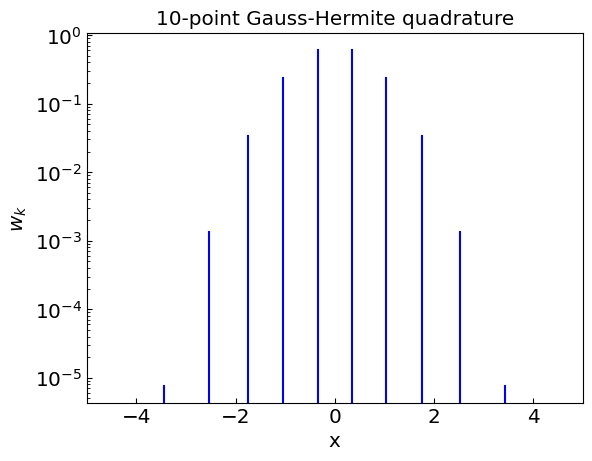
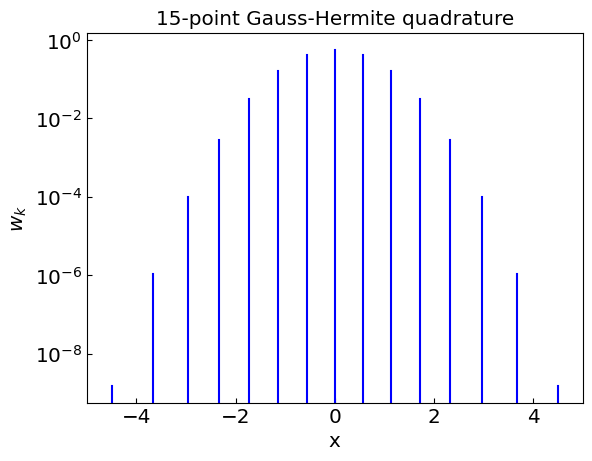
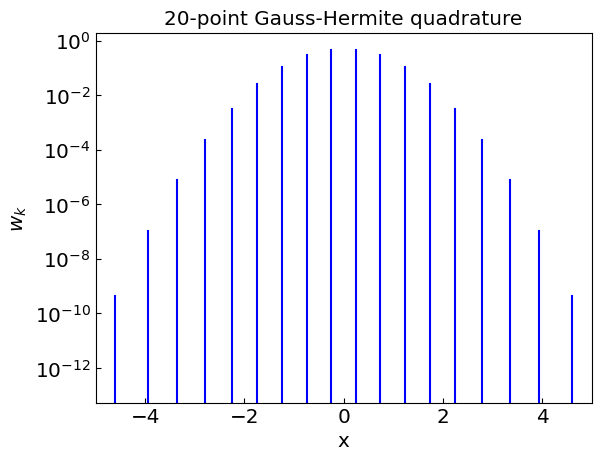
Example: Relativistic quantum distribution#
Let us revisit the density of a relativistic quantum gas
where \(\tilde m = m/T\) and \(\tilde \mu = \mu / T\).
This expression can be cast in a form
with
One can see that the function \(f(x) \sim x^2\) in the limit \(x \to \infty\), thus Gauss-Laguerre should be a good choice for evaluating this type of integral.
Let us do that using a 32-point Gauss-Laguerre quadrature.
# Precomute 32-point Gauss-Laguerre quadrature
laguerrexw32 = laguerrexw(32)
# Parameters
T = 150 # MeV
mu = 0
m = 138 # MeV
d = 1
eta = 0
# Function for integration
def fThermal(x):
x = float(x)
return d * x**2 * np.exp(x) / (2 * np.pi**2) / (np.exp(np.sqrt((m/T)**2 + x**2) - mu/T) + eta)
def nIntegral(n_nodes = 32):
quad = laguerrexw32
if (n_nodes != 32):
quad = laguerrexw(n_nodes)
return integrate_quadrature(fThermal, quad)
def nT3num(inT, inMu, n_nodes = 32):
global T, mu
T = inT
mu = inMu
return nIntegral(n_nodes)
# Maxwell-Boltzmann
T = 150 # MeV
mu = 0
eta = 0
print("Computing Maxwell-Boltzmann integral")
print("T = ",T)
print("mu = ",mu)
print("eta = ",eta)
print("n(T,mu) = ",nT3num(150,0,32))
Computing Maxwell-Boltzmann integral
T = 150
mu = 0
eta = 0
n(T,mu) = 0.0847224926254013
#Bose-Einstein
T = 150 # MeV
mu = 0
eta = -1
print("Computing Bose-Einstein integral")
print("T = ",T)
print("mu = ",mu)
print("eta = ",eta)
print("n(T,mu) = ",nT3num(150,0,32))
Computing Bose-Einstein integral
T = 150
mu = 0
eta = -1
n(T,mu) = 0.09332222578416971

